Recent Enhancements | Get Started | Training | Global Support

See also: Updates Home
The ProQuest platform user experience is driven by deep analysis of researcher behaviors, extensive testing with users and librarians, beta testing with a variety of customer development partners, and large-scale A/B testing. Here's a summary of our most recent updates to the ProQuest Platform. As always, we welcome your feedback.
For more on ProQuest Research Assistant, our new AI-powered tools that help users create more effective searches, quickly evaluate documents, and engage with content more deeply, click here. You can also read the FAQ here.
Recent Enhancements
September 2025:
Research Assistant Topic Visualization
Users of ProQuest Research Assistant can now request to visualize the important topics addressed by a document and their relationship to each other.
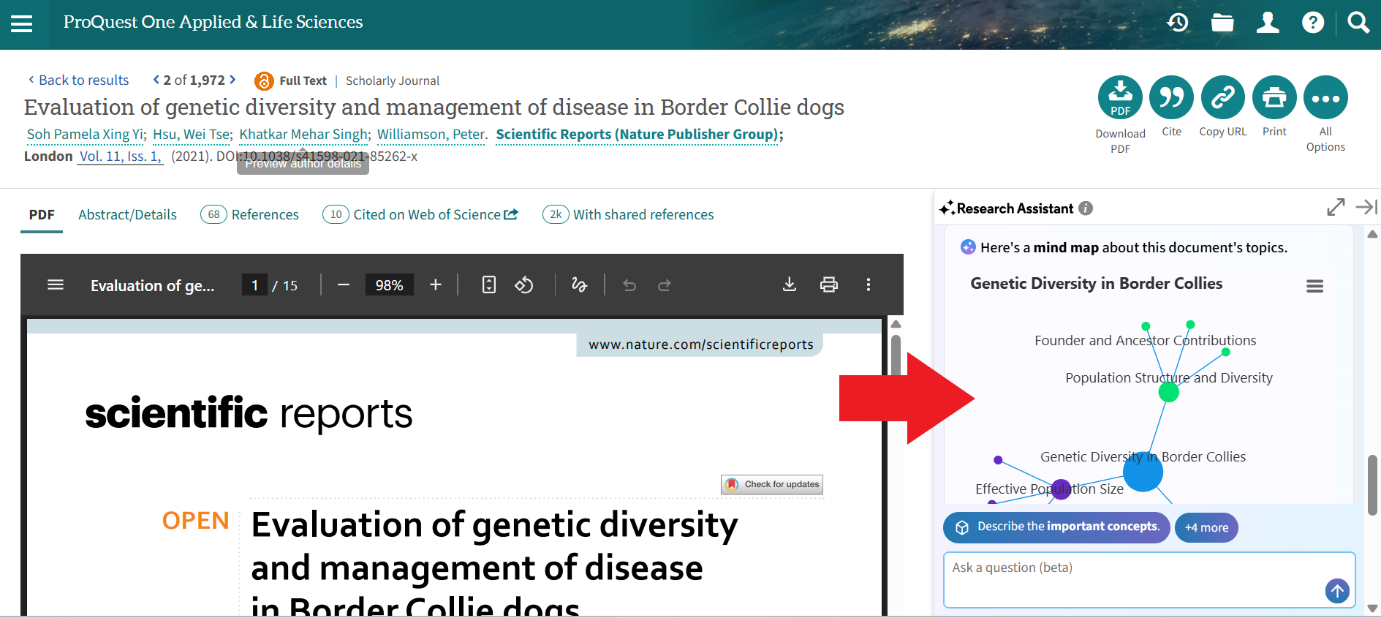
For each topic, users can click to see a short initial conclusion of the document’s findings and ask for more detail as needed. They then have the option to search for additional documents associated with that topic.
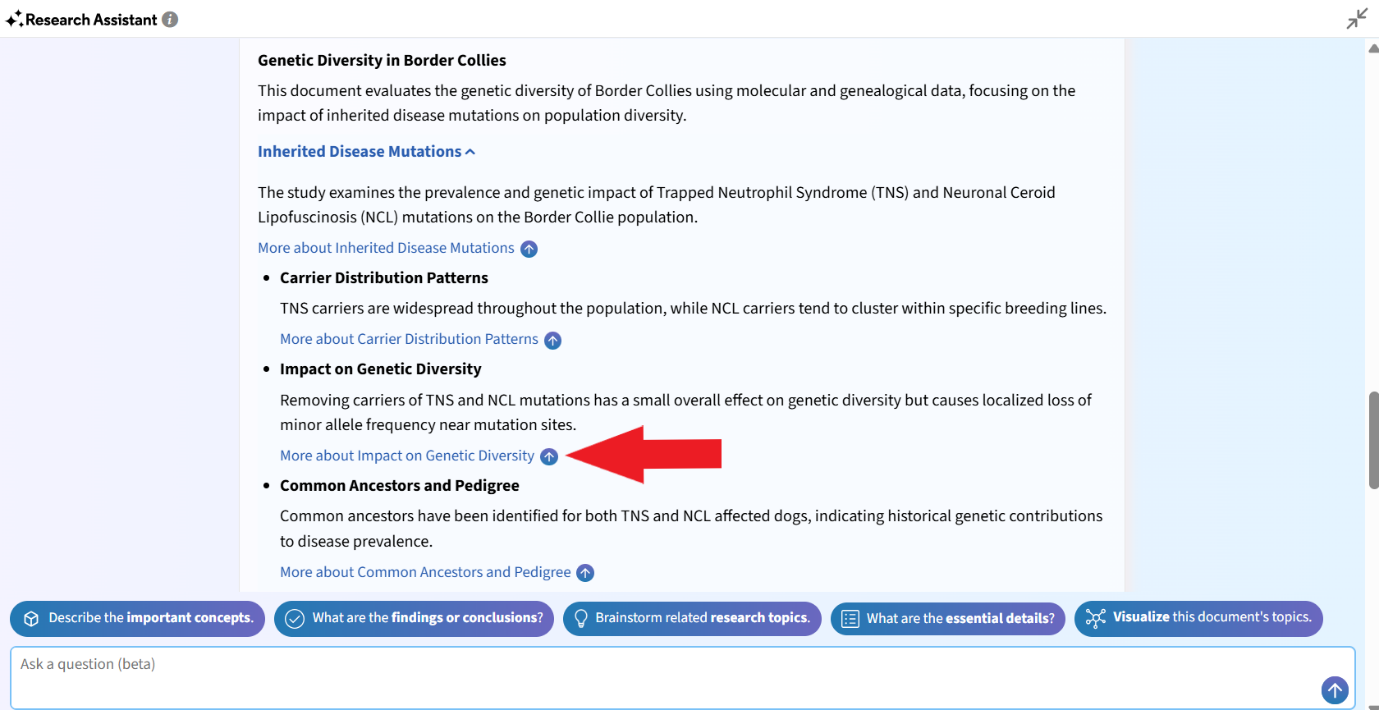
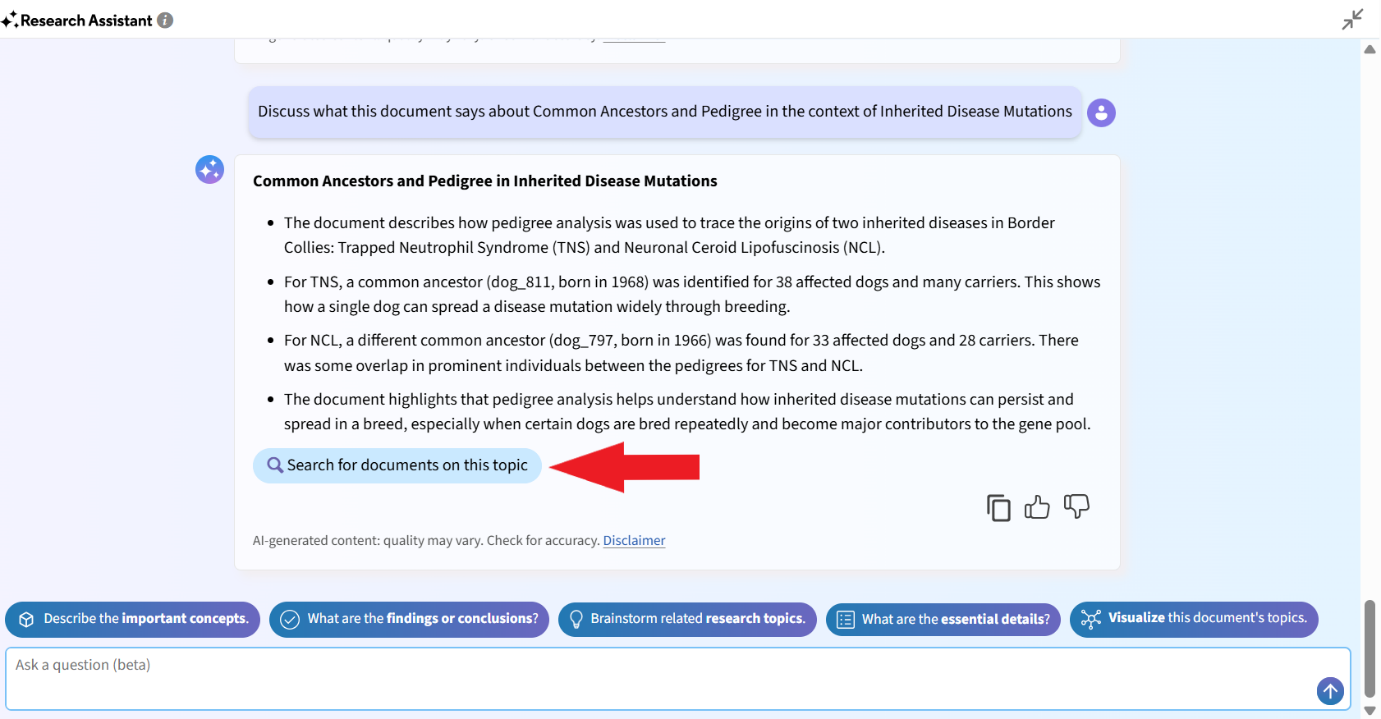
July 2025:
Key Takeaway Translations
ProQuest Research Assistant now allows users to translate Key Takeaways into select languages.
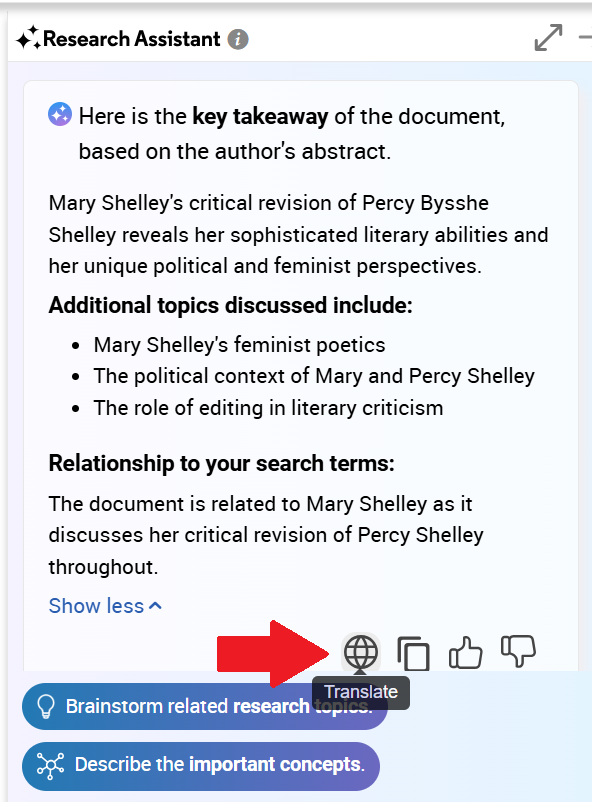
ProQuest Research Assistant is included in ProQuest Central, ProQuest One Academic and other ProQuest One products.
May 2025:
Essential Details (ProQuest Research Assistant)
Products with ProQuest Research Assistant will now allow users to ask for the ‘Essential Details’ of documents on the ProQuest Platform. This will enable researchers to understand a document more efficiently and quickly evaluate whether it is relevant for their needs.
Based on its analysis of the document’s full text, the Research Assistant will classify it into a category (e.g., Research-based documents, Opinion and Criticism, Factual/News Documents, Creative Works, etc.) and summarize its appropriate essential details.
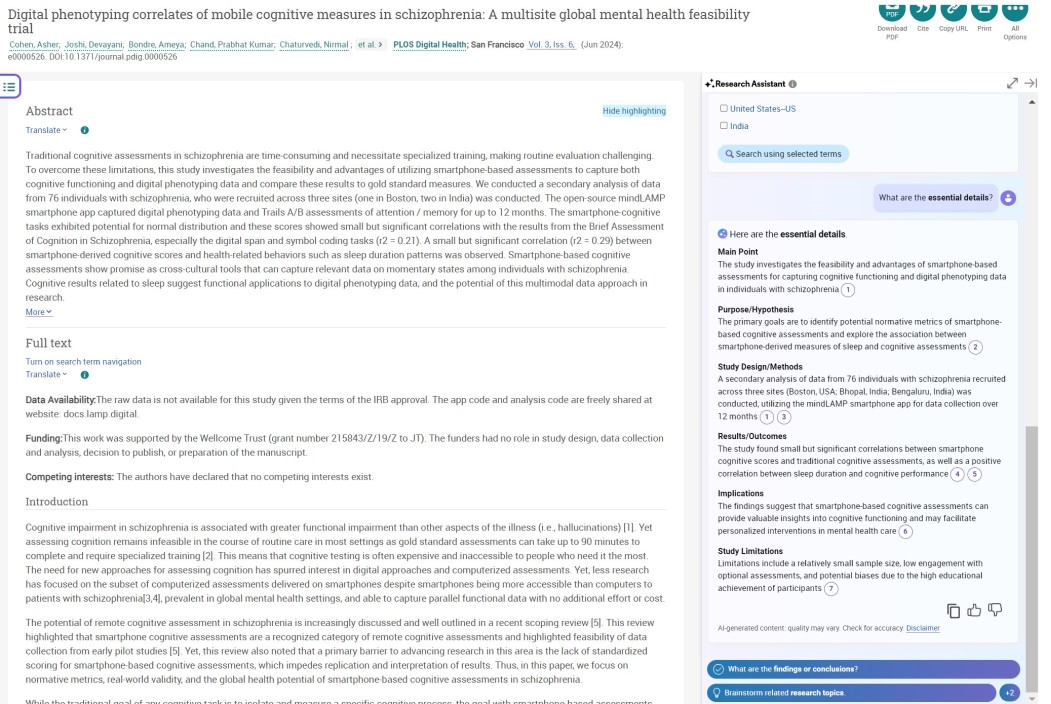
For example, for Research-based documents (scholarly journal articles, studies) the Research Assistant will return the following:
- Main Point, Purpose/Hypothesis, Study Design/Methods, Study type (sample size, population studied, location, and key methods), Results/Outcomes, Implications, and Study Limitations
For Creative Works (novels, short stories, poems, plays):
- Main theme, Characters, Setting, Emotional Tone, Plot Structure, Symbols/Motifs, and Narrative Perspective
Users will then see the quote that informs each of the Essential Details, with a link to navigate directly to the relevant section of the full text to examine the quote in context.
Document -Specific Thumbnails
Thumbnail images of select documents will now display on the search results page, giving users a quick preview of the content.
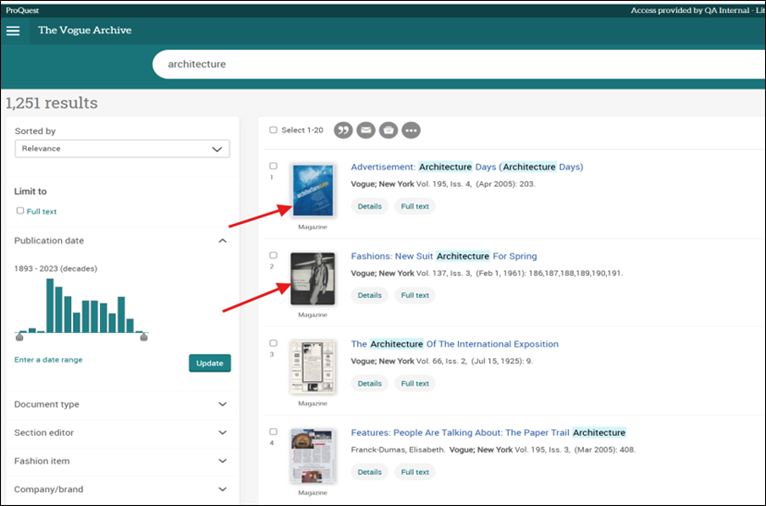
Fit to Width/Height in Image Viewer
Users can now easily fit an image to the width or height of the page using the “fit to width” and fit to height” icons, which have been added to the image viewer toolbar.
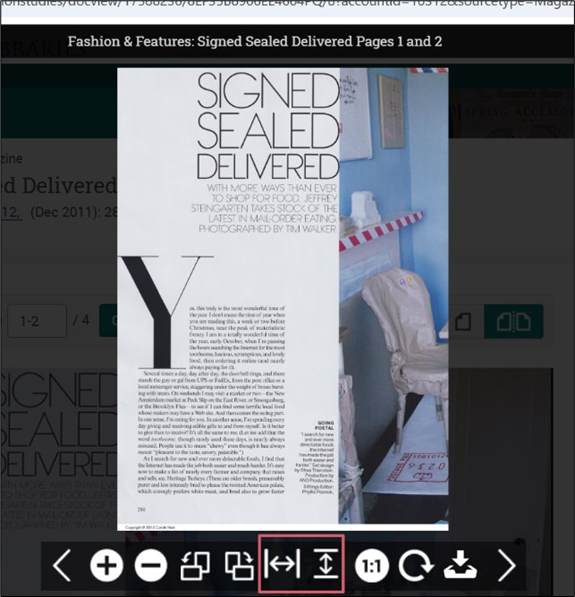
April 2025:
Improvement of Search Helper Terms (ProQuest Research Assistant)
As part of ProQuest’s efforts to optimize platform features for an ideal user experience, the AI-powered search helper terms present in select products have been updated to improve the relevance of suggestions.
Suggested search terms are derived from a large language model (LLM) and can be added to a search with a single click, aiding users in narrowing down their results to a manageable set of relevant content. The latest update also enhances the Search Helper with multilingual capabilities, ensuring that term suggestions align with the language used in the search query.
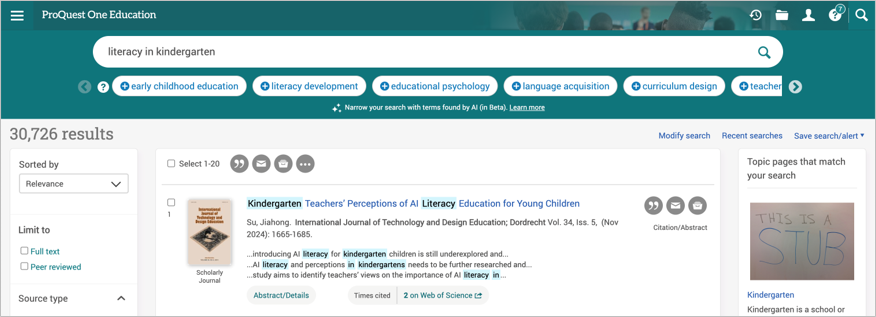
Expanded View for Research Assistant
Products featuring ProQuest Research Assistant now allow users to expand the panel into a larger view, providing ample space to interact with its capabilities. This expanded overlay allows users to interact with the Research Assistant while remaining anchored to the document text, and seamlessly transition between the two views.
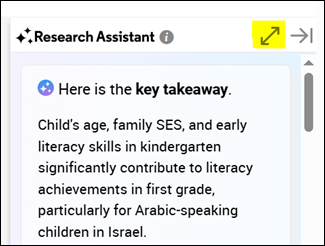
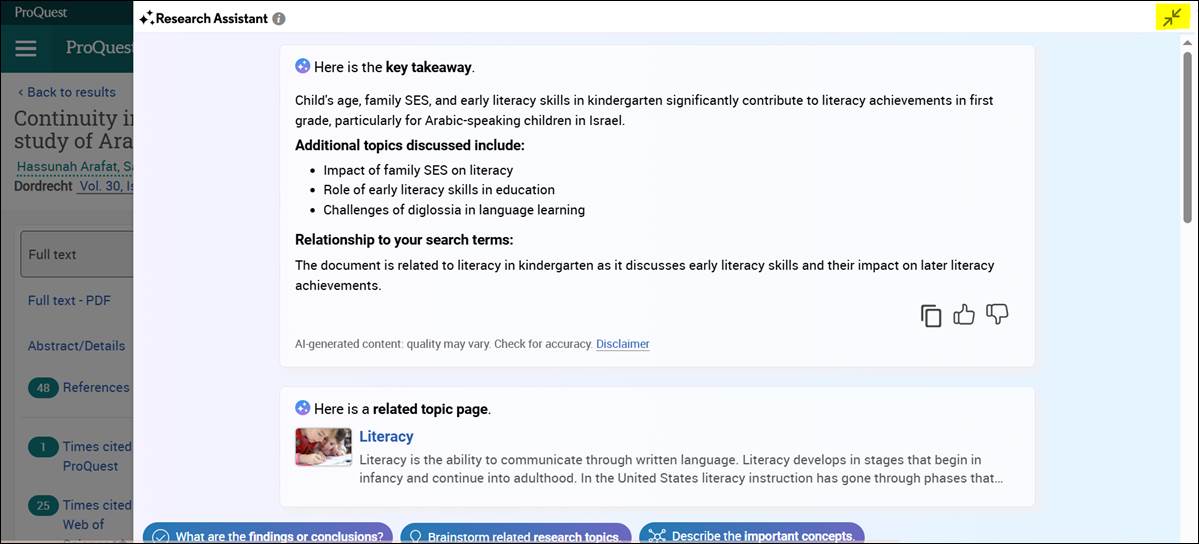
March 2025:
Session Restore After Timeout
The ProQuest Platform UI can now capture key session working elements periodically and store them for recall if a new session starts.
Sessions can be restored if the user has run at least 6 searches or marked at least 10 documents before their session times out. Users do not need to have logged into My Research, however they must be using the same machine and browser software without clearing cookies.
Users will be prompted to restore their session if the presence of a previous session meeting the criteria above is recognized via a cookie set by the ProQuest Platform. Search history and selected documents will be restored, and the user may resume work captured at the point when their previous session timed out.
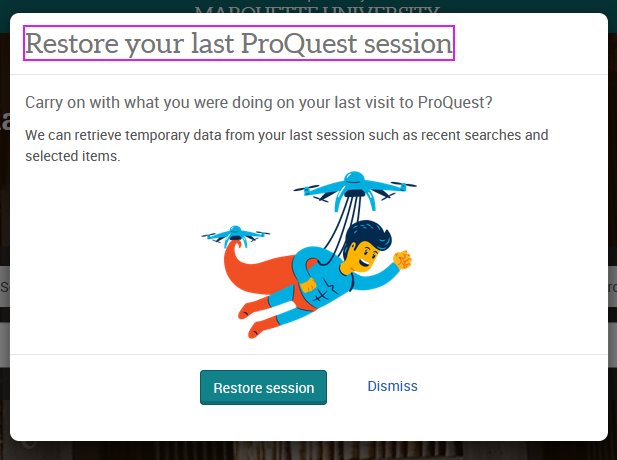
AI-Powered ProQuest Research Assistant is now live in selected products!
ProQuest Research Assistant harnesses AI’s capabilities and applies them in a responsible, reliable manner as a research companion for students. Powerful features allow users to:
- Easily craft more effective and targeted searches
- More effectively review, analyze, and interrogate documents
- Quickly evaluate the usefulness of each document for your research
- Receive guidance on next steps including choosing a research topic
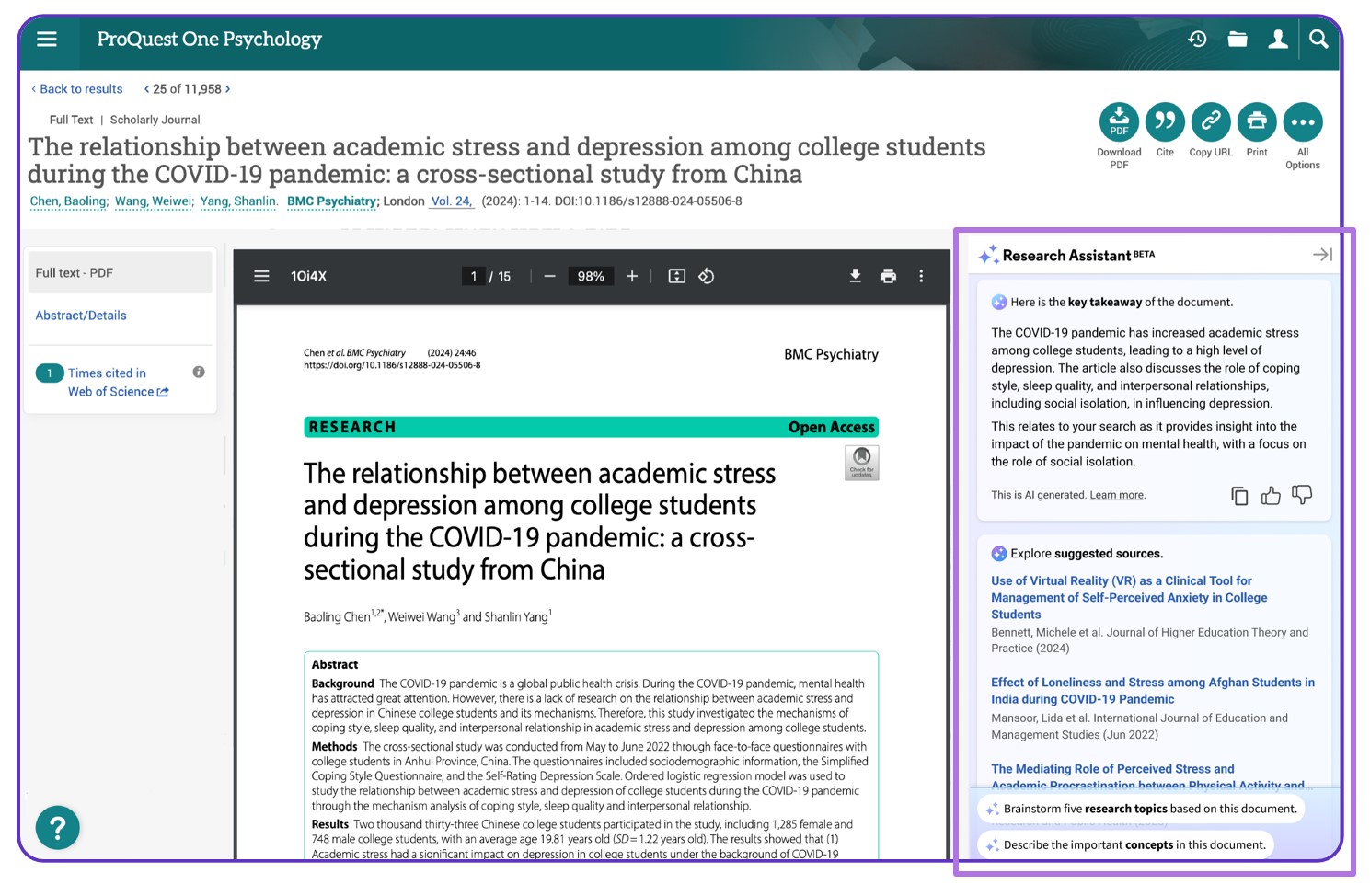
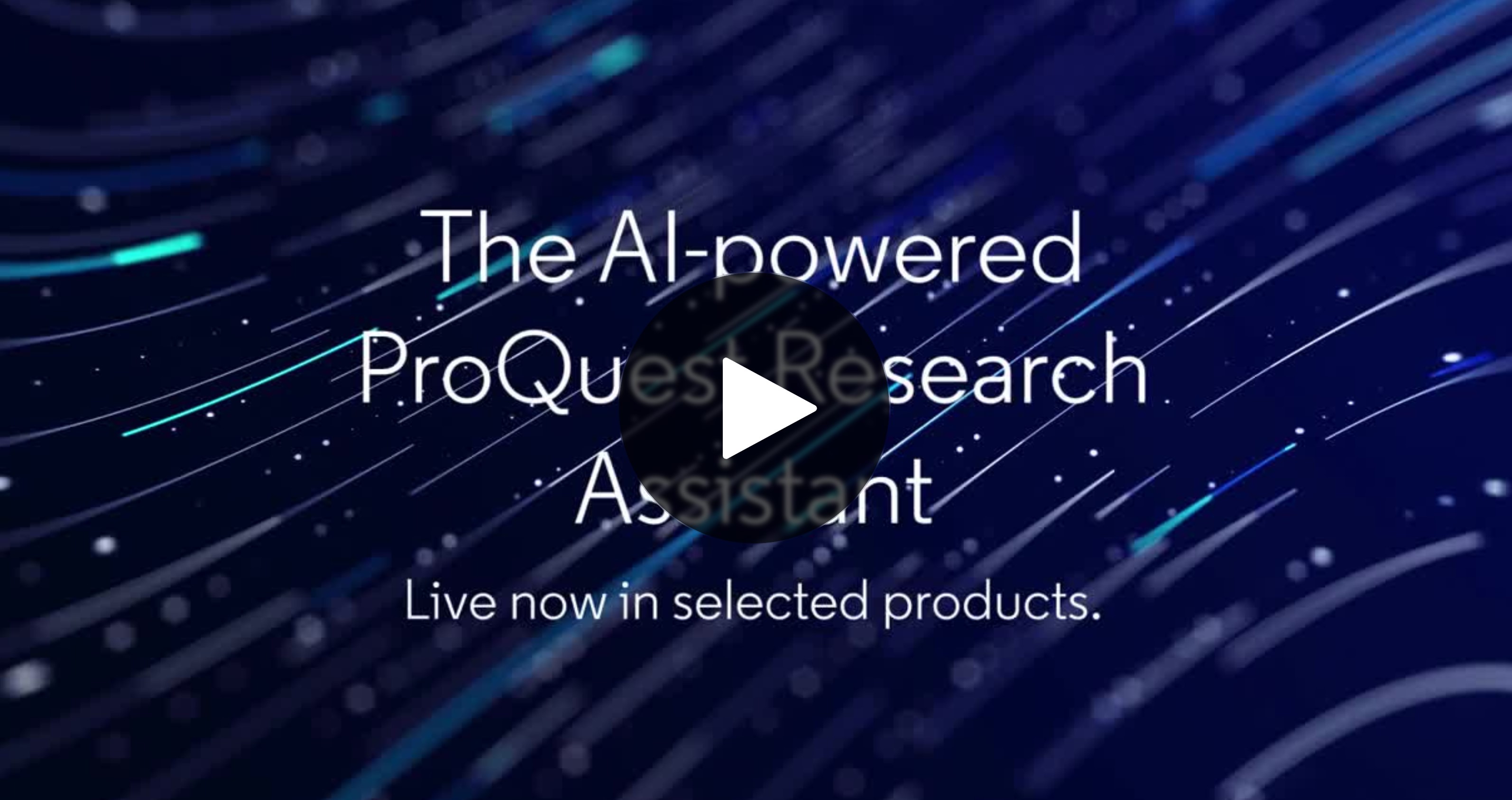
Watch the video above or find out more here.
August 2024: ProQuest One Business enhanced browse.
Business-specific subject terms are applied across its content and presented to the user via a dedicated thesaurus. When viewed via the Thesaurus, the user can home in on any of the twelve categories.
The same ability to narrow by subject category has also been added to the Browse by Subject area, offering a more focused view into its nearly 3000 subject terms.
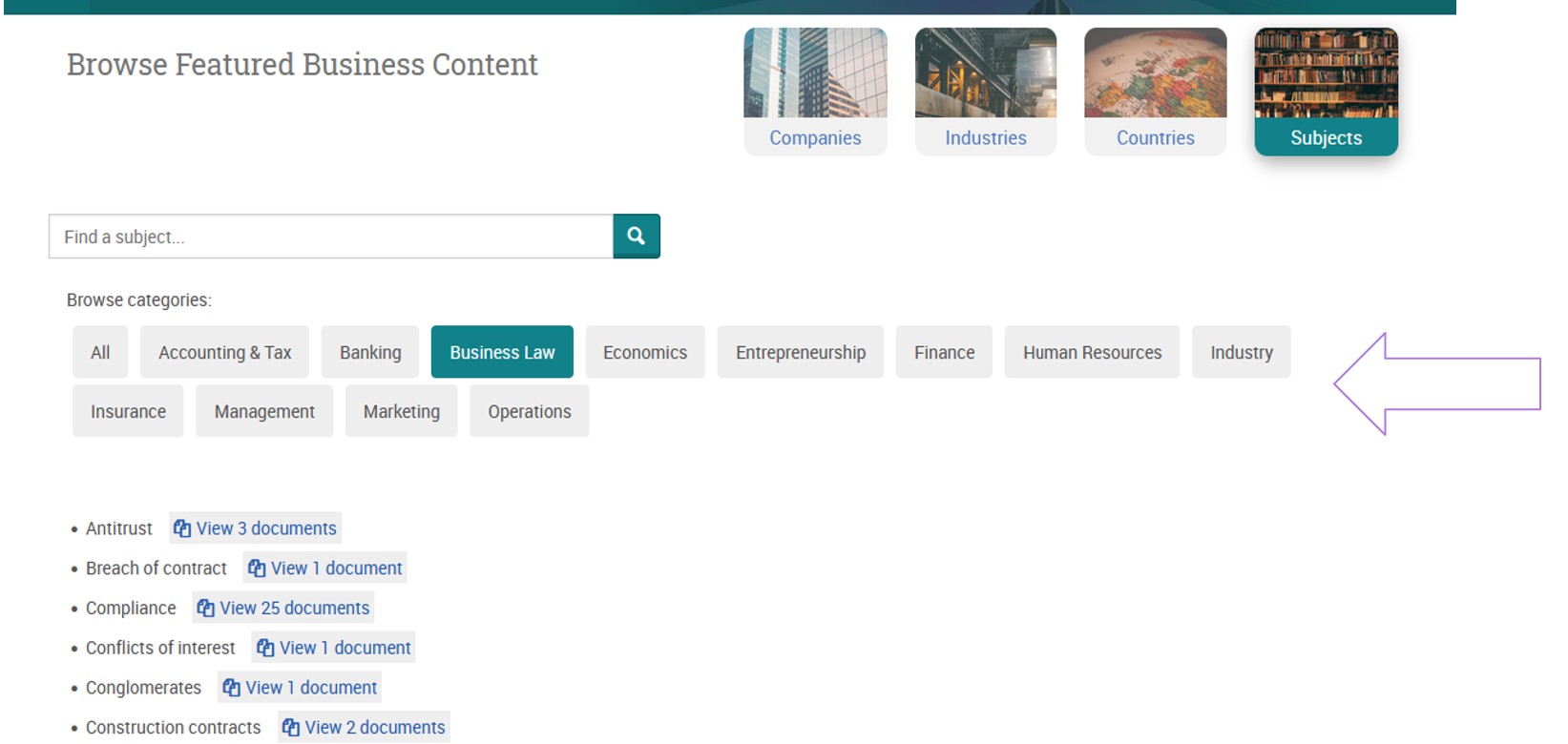
March 2024: Updates to ProQuest One Psychology
The PTSDpubs database content now included. Covers the Published International Literature On Traumatic Stress, includes citations to all literature on post-traumatic stress disorder (PTSD) and other mental-health sequelae of traumatic events, without disciplinary, linguistic, or geographical limitations, and to offer both current and retrospective coverage.
Health & Wellbeing eBook Collection content now integrated. Customers with subscriptions to both products will now see their ebook content in the ProQuest One Psychology interface.
October 2023 : Search Syntax for Saved Searches
To better support users working with complex queries across sessions, the ProQuest Platform now allows users to reference saved searches in their My Research profile when using search reference syntax (AKA set searching).
Researchers with saved searches in their My Research profile can use the syntax [MR#] (where # is the corresponding number of the search they are referencing) or [MR:name] (where name refers to the particular name they have given their query) to call up searches done in prior sessions.
Users may still utilize the [s#] syntax to reference a previous search in their current session, but this new feature will provide added benefits for advanced researchers engaging with complicated queries over an extended period.
Example showing name and number of saved search in My Research:
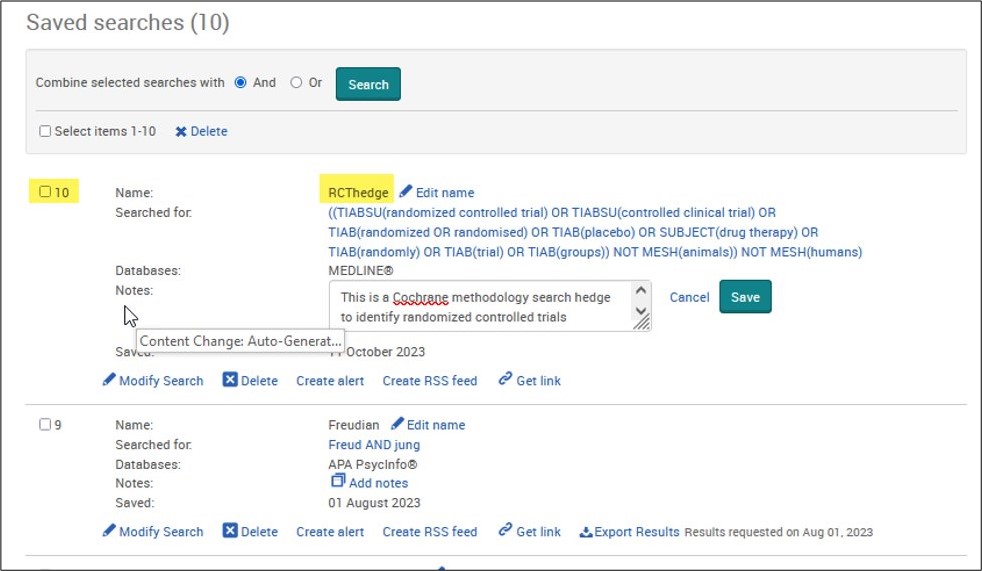
Search query using [MR:name] syntax:
![Search query using [MR:name] syntax](/servlet/rtaImage?eid=ka2QO0000002vOn&feoid=00N3r00000HQqaQ&refid=0EMDo000002YhEZ)
Questions? Please contact the ProQuest Technical Support team.
Back to top
##
September 2023: ProQuest Platform Now Includes Web of Science Author Details
Web of Science Author Profiles are now available in ProQuest Platform. The author information can help researchers determine which authors are subject matter experts on a given topic. This information helps users identify opinion leaders, and investigate and find collaborators.
Mutual ProQuest and Web of Science customers and users will see the premium author page when they click to view the Web of Science researcher profile from ProQuest Platform. Additionally, on the ProQuest Platform author pop-over, mutual customers can also view author data including the number of publications and times cited.
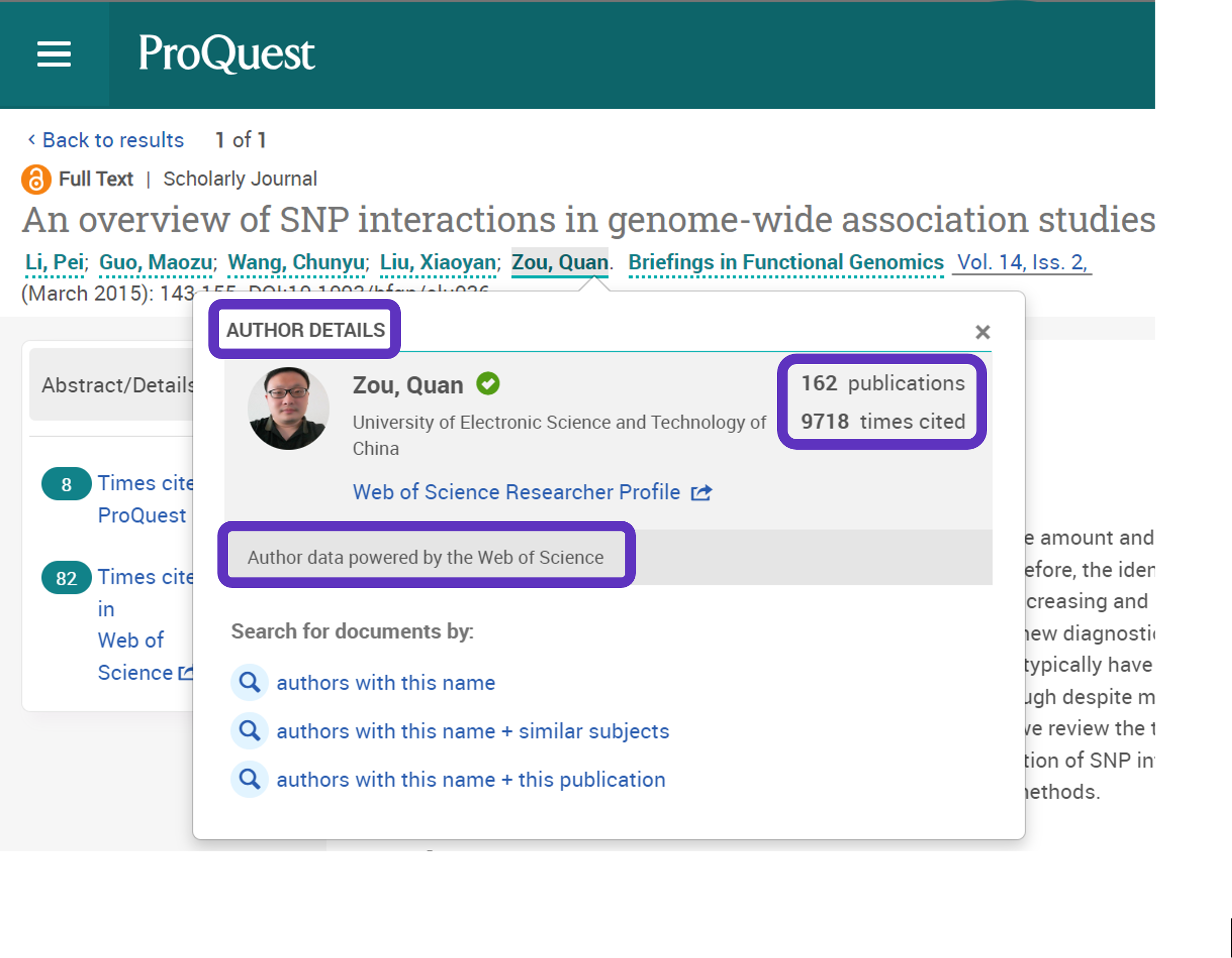
These enhancements continue to support ProQuest users with insights and key metrics at the point of user need.
Questions? Please contact the ProQuest Technical Support team.
Back to top
##
May 2023 : ProQuest Platform Now Includes Citation Counts from Web of Science
ProQuest Platform users will now see the Web of Science Times Cited count on ProQuest result and article record pages, with the ability to link back to the Web of Science. This integration is available to all ProQuest Platform users. Clicking the "Times cited in Web of Science" link takes users to a free-access version of the Web of Science article. From there, Web of Science subscribers may view the full record and documents that cite it.
Access to Web of Science citation counts in ProQuest Platform supports confident discovery and assessment to help users quickly locate key papers on topics of interest, and stay up to date with the latest research.
- ProQuest users can leverage the Web of Science citation index for scholarly research—offering confident discovery, access, and assessment
- Quickly locate key papers on topics of interest and stay up to date with the latest research
- Citation counts from Web of Science are integrated into ProQuest results pages, cited by and document pages
- This enhancement is available for all ProQuest platform users
WoS Times Cited – ProQuest Search Result Page:
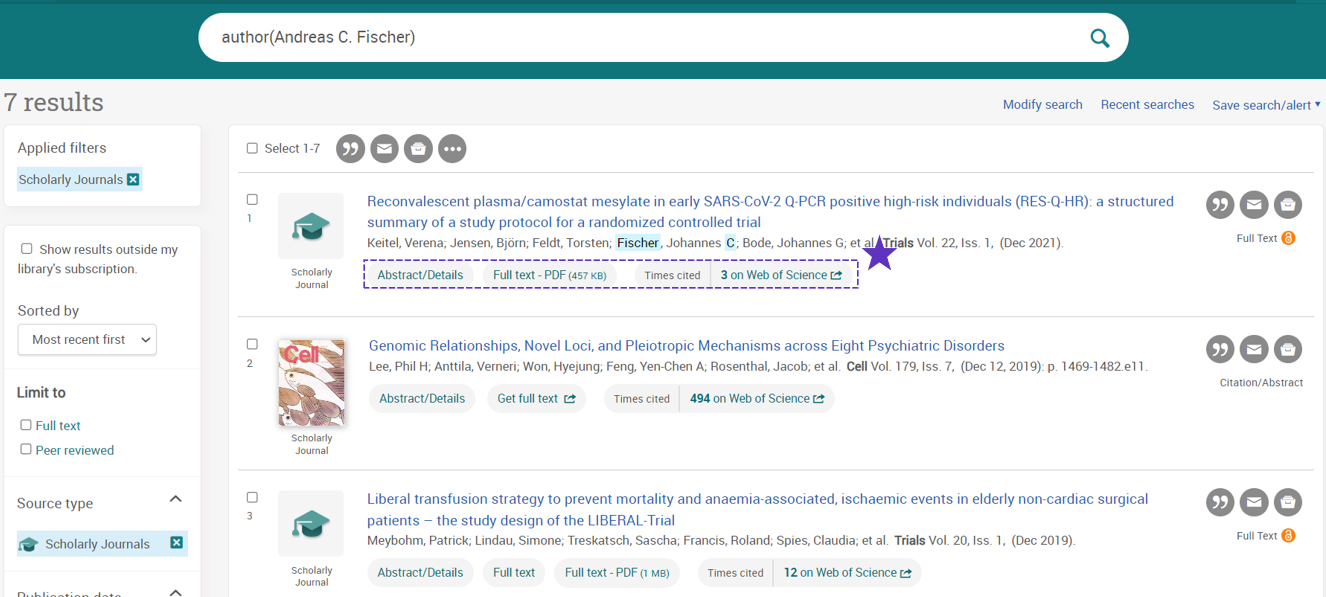
Example showing Times Cited on Web of Science and number of references:

WoS Times Cited – ProQuest Document Page:
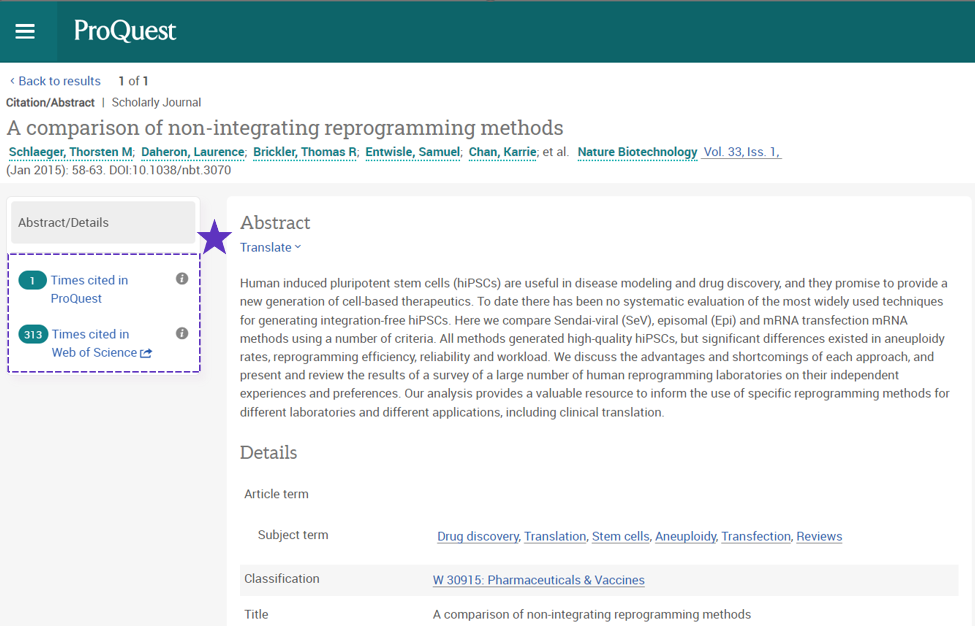
Questions? Please contact the ProQuest Technical Support team.
##
Back to top
March 2023: Integrating Web of Science Data Insights into ProQuest Platform
Insights from Web of Science are being integrated into ProQuest Platform, offering ProQuest users key metrics to help inform their research journey at their point of need. These enhancements connect features of the Web of Science and ProQuest platforms across publication titles, documents and authors.
Available as of March 2023:
Journal Citation Report metrics in ProQuest Platform help users assess the world’s leading journals with publisher-neutral data and gain insight into publications and documents to make informed, confident decisions.
- Journal Citation Indicator displays for all ProQuest Platform users.
- Journal Impact Factor displays only for mutual Web of Science and ProQuest Platform customers

Coming Soon:
- Web of Science Author Profiles will become available in ProQuest Platform to help researchers determine which authors are subject matter experts on a topic to identify opinion leaders and investigate and find collaborators.
- Web of Science citation counts will become available in ProQuest Platform supporting confident discovery and assessment to help users quickly locate key papers on topics of interest and stay up to date with the latest research.
These enhancements support ProQuest users with insights and key metrics at the point of user need.
Questions? Please contact the ProQuest Technical Support team.
January 2023: Round-up of recent and upcoming ProQuest Platform enhancements
New Authentication Option with Google Single-Sign-On & Results Page Enhancements
Google Single-Sign-On (SSO) Now Available
Users accessing ProQuest Platform through their academic institution can now seamlessly authenticate into ProQuest Platform using their institutional Google Account credentials. Google Single-Sign-On is an authentication option for products available on the ProQuest platform and facilitates easy access to the library’s ProQuest databases.
Students, faculty, and staff have one fewer password to remember, and librarians and electronic resource administrators can use the Google Account capabilities to configure and manage product access for their users. Once logged-in, users can easily share and save articles using Google Workspace for Education tools like Google Docs.
Google SSO is just the latest in a series of platform enhancements by ProQuest in recent years to facilitate deeper integration with student and faculty workflows.
To learn more about configuring Google Account Single-Sign-On for your ProQuest solutions, visit the Support Center article.
Google Single Sign-On: new authentication option
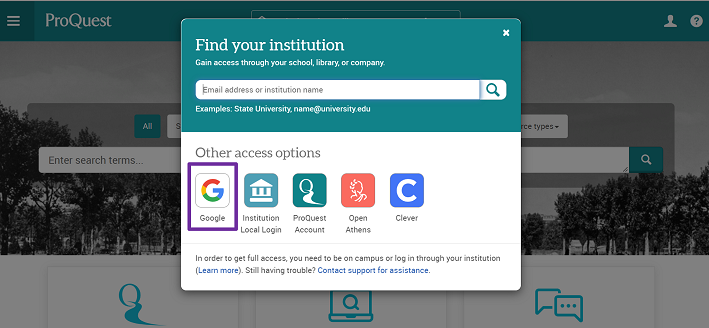
ProQuest Platform Enhancements Support Users with Features on Search Results Pages
ProQuest is continuing to optimize the ProQuest Platform based on customer and user feedback. Recent enhancements are available which offer new options for assessing and interacting with search results.
- Use Tools have been added to individual records in search results, offering users options to work directly within each search result item. As a user moves through the results list, individual items can be cited, emailed or saved to My Research. This change offers users more flexibility with how users interact with search results, offering options for individual result Use Tools, or Use Tools that apply to multiple items within the search results list.
- The search field on results pages can now be hidden from view by the user if they desire, allowing for more focus on the results list.
- Coming Soon: A “Quick Look” option is available on search results allowing users to quickly move item-by-item through the results list to get key information. Users see an overview of each item, including abstract and indexing if available and link to full text if available. This feature helps users gain a fast picture of how useful and relevant search results items are to their research question without needing to click into every result item.
Questions? Please contact the ProQuest Technical Support team.
“Use Tools” Available on Individual Records in Search Results
Cite, email or save individual items
“Quick Look” Option on Search Results
Evaluate search results, move item-by-item through results list to evaluate key information.
##
Back to top
March 2022 : New Enhancements are available to Search, Results, and Document Pages
ProQuest is continuing to optimize the ProQuest platform based on customer and user feedback. As of March 31, 2022, enhancements are available which offer new options for searching on source types and features to help users interact with content on results and document pages. These enhancements include:
- Additional selections on the main Search Page for searching by content source type, as well enhancements that more visually engage users, and provide a clearer indication of how many databases are being searched.
- A new “Quick Look” feature better allows users to preview results without leaving the search Results Page.
- Suggested Sources on Document Pages offer recommendations via a more visual, intuitive panel presentation.
We suggest updating training material to reflect these new enhancements. More detail, including screenshots, can be found below.
ProQuest is committed to continually listening to the library community, and we welcome your feedback.
Questions? Please contact the ProQuest Technical Support team.
SEARCH HOME PAGE ENHANCEMENTS
New Background Images: An updated set of background images are now visible on the main Search Page, offering a more visually appealing experience with visual representations of topics and content available in the platform.
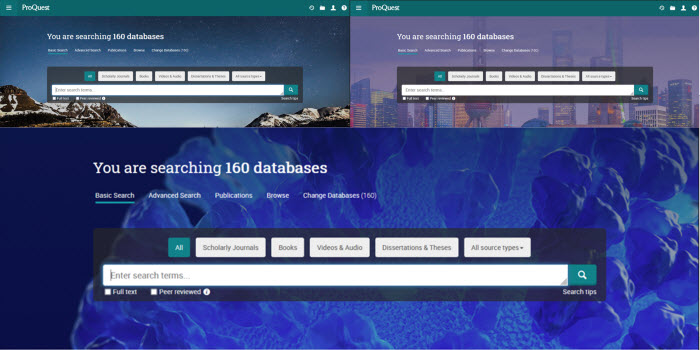
More Clarity of Number of Databases: A headline with the number of databases being searched has been implemented to help users clearly understand which databases they are searching. Users are often given assignments to use specific product databases for assignments and/or may not realize how many databases they are searching, particularly if they don’t initially start their search directly within a specific database. A large headline describing what the user is searching offers better context for the search, and helps users determine whether to select a database or continue with a cross-search.
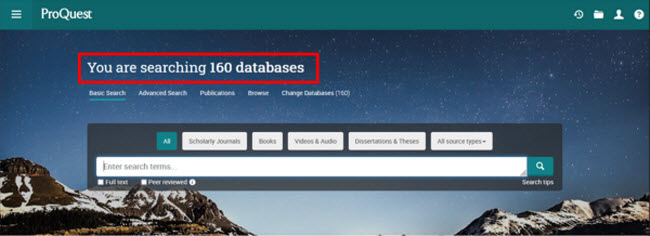
More Source Type Filter Options: An option to select and search any available content source type is now provided above the main search field. The available source types are based on the users’ subscriptions and selected databases. This option now allows for multiple selections—letting a user select more than one source type, rather than just a single value, which is the current default. These additional options can help users create a more specific and targeted search.
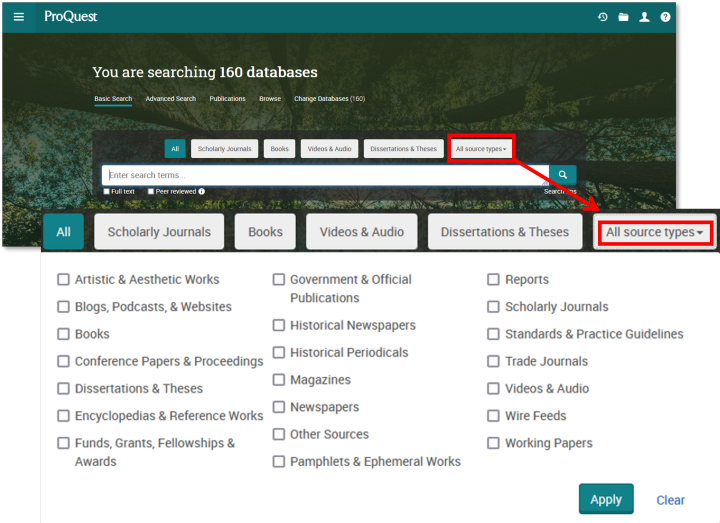
RESULT PAGE ENHANCEMENTS
New "Quick-Look" Option: A “Quick Look” option now appears on each respective results item, helping users more quickly and easily evaluate the results. When “Quick Look” is selected, a panel opens on the Results Page where a user can see the full abstract & subject indexing (where applicable), as well as the document tools users have come to expect including citing, saving to My Research, email and printing. This new “Quick Look” feature allows users to preview specific results, and access document options, all without leaving or losing their progress on the Results Page.
DOCUMENT PAGE ENHANCEMENTS
New “Suggested Sources”: The current “Related Items” available on Document Pages has been renamed as “Suggested Sources” and enhanced with a new panel presentation. The updated layout allows users to explore suggested sources with more context and helps them better evaluate the recommendations.
December 2021: Document and navigation enhancements to support all researchers
As part of ProQuest’s ongoing effort to listen and respond to customer and user feedback, we are pleased to announce upcoming enhancements to the ProQuest platform. As of December, new enhancements are available to help users better view and interact with full-text documents and more easily navigate the ProQuest platform.
These recent platform enhancements…
- support users to more easily find options that help them navigate their way throughout the site
- optimize the user experience when viewing documents to help researchers more easily utilize full-text content and understand and access important options available when interacting with documents
Please make note of document view and navigation enhancements, and where applicable, we suggest updating any training materials to reflect these enhancements.
ProQuest is committed to continually listening to librarians and users to create an interface that best meets the needs of both undergraduates and experienced researchers in a way that aligns to their desired workflow.
Questions? Please contact the ProQuest Support team.
NAVIGATION IMPROVEMENTS
Main Navigation: The main navigation menu (top left “hamburger menu”) has been enhanced to assist users to more quickly and easily access options that help them navigate their way throughout the site.
- To better align with preferred workflows of researchers, the main menu has been revised to include options to search and browse the ProQuest platform in addition to the existing links for information about ProQuest as an organization.
- Users have a simplified view to help them get to where they want to be in the platform, with the location and placement of core search and browse options now aligning to where users expect to find them.
- Consolidation of options into the main menu frees up space on each page—putting better focus on core functions and the content of each respective page.
|
Main Navigation Menu (Updated as of December 2021):
The main menu is now updated with search and browse options.
|
Original Main Navigation Menu:
|
OPTIMIZING DOCUMENT VIEWING & OPTIONS
Document pages have been optimized to help researchers more easily consume both the full-text information contained within a given document, as well as the options available for interacting with documents. These changes to the document layout apply broadly across the majority of source types in the platform, with a few exceptions including books, video and literary works which are not being changed at this time.
Streamlined Document Pages: The document page template has been revised to put more focus on the content and text, maximizing the “space” for viewing the document text and options, with less scrolling for users. Additionally, streamlined document pages now help make database names more apparent, supporting students and researchers who are often given assignments to use specific research databases.
Search Improvements on Document Pages: Search options have been moved to the main navigation header, allowing a user to search either within the selected database(s) or more widely across all available databases. If a user has arrived on the document page from a location outside the ProQuest platform, this search field will be visible by default. For users who are searching directly within the platform and have arrived on the document page, this search field will not be visible, but can be accessed by clicking the magnifying glass icon.
Updated Document View & Navigation: Improvements have been implemented to better align the document user experience to how users prefer to interact with the content.
- On the document page, the “document navigation” has been moved to the left and better highlighted to focus on references and citations in a clear and intuitive way, helping users more easily identify and navigate options available for a document.
- A notable emphasis is placed on the “Cited by” area of the document page to help highlight this key information which puts individual documents within the context of other closely related research, including items that build on the original document.
- The Document Navigation is now “sticky” and follows the user as they scroll on the page. This helps users more efficiently navigate the document and offers context and options around the document at the point of use instead of options being out-of-sight at the top of the page.
Streamlined Top of Document Page (Updated as of December 2021): Improved use of space to bring content “up” higher in the document template, allowing for less scrolling and more focus on page content and database name.

Original Top of Document Page:
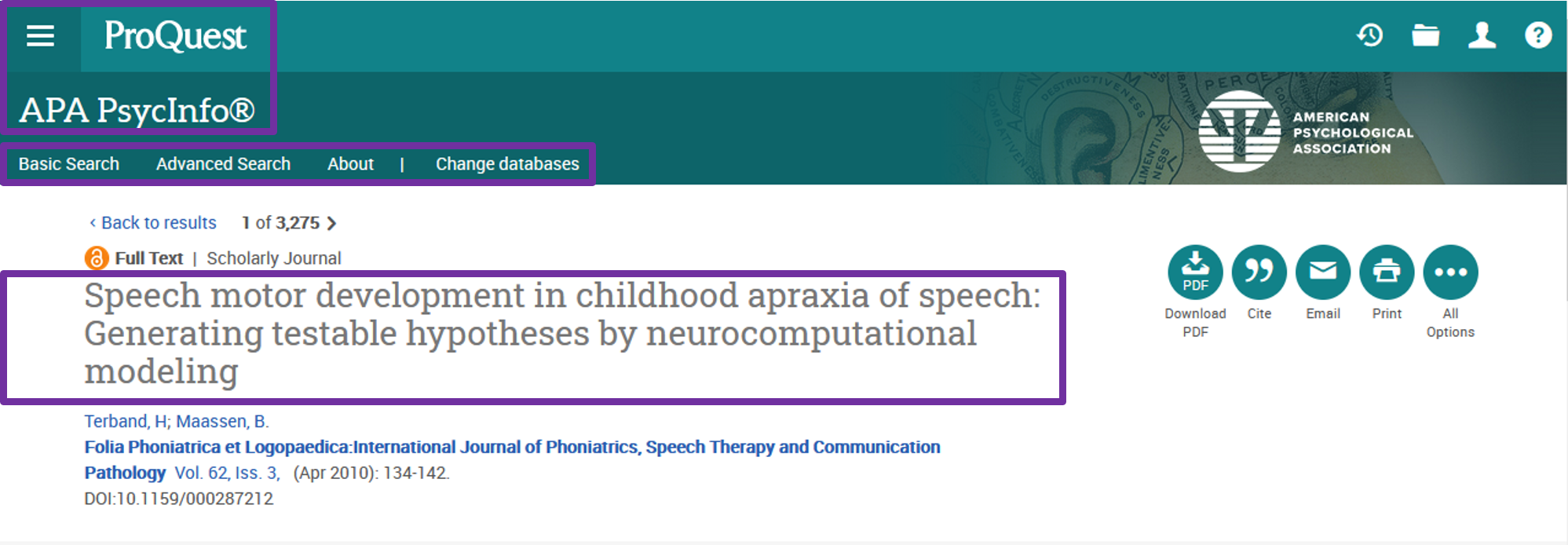
Search Improvements on Document Pages (Updated as of December 2021): Search options have been moved to the main navigation header, allowing a user to search either within the selected database(s) or more widely across all available databases. Clicking the magnifying glass icon will display a large search box within the main navigation header. If a user has arrived on the document page from a location outside the ProQuest platform, this search field will be visible by default.


Original Search on the Document Page:

Updated Document View & Navigation (Updated as of December 2021): Document view and navigation options are now on left of the document including references, cited by, and shared references options.
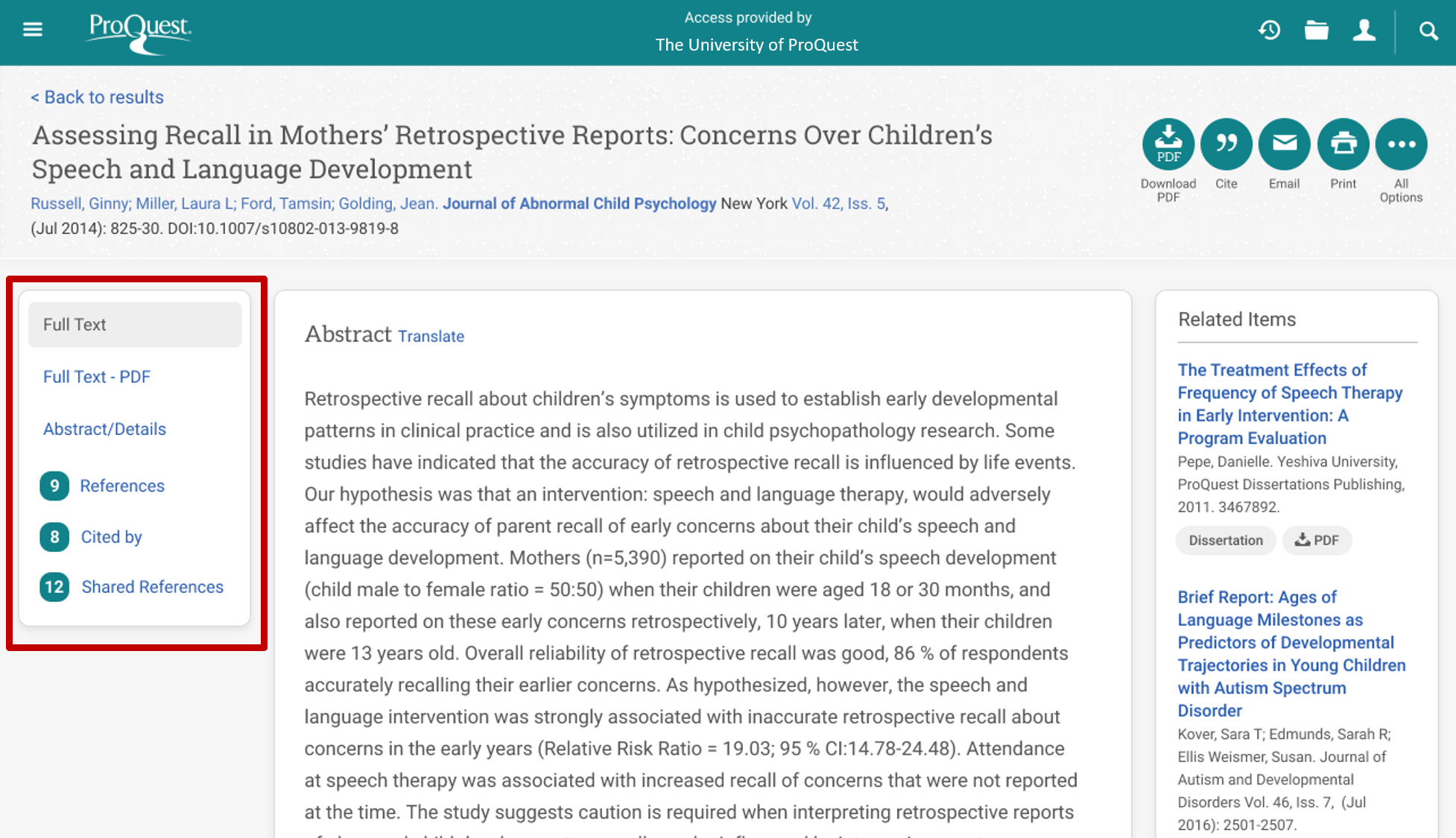
Original Document View & Navigation:
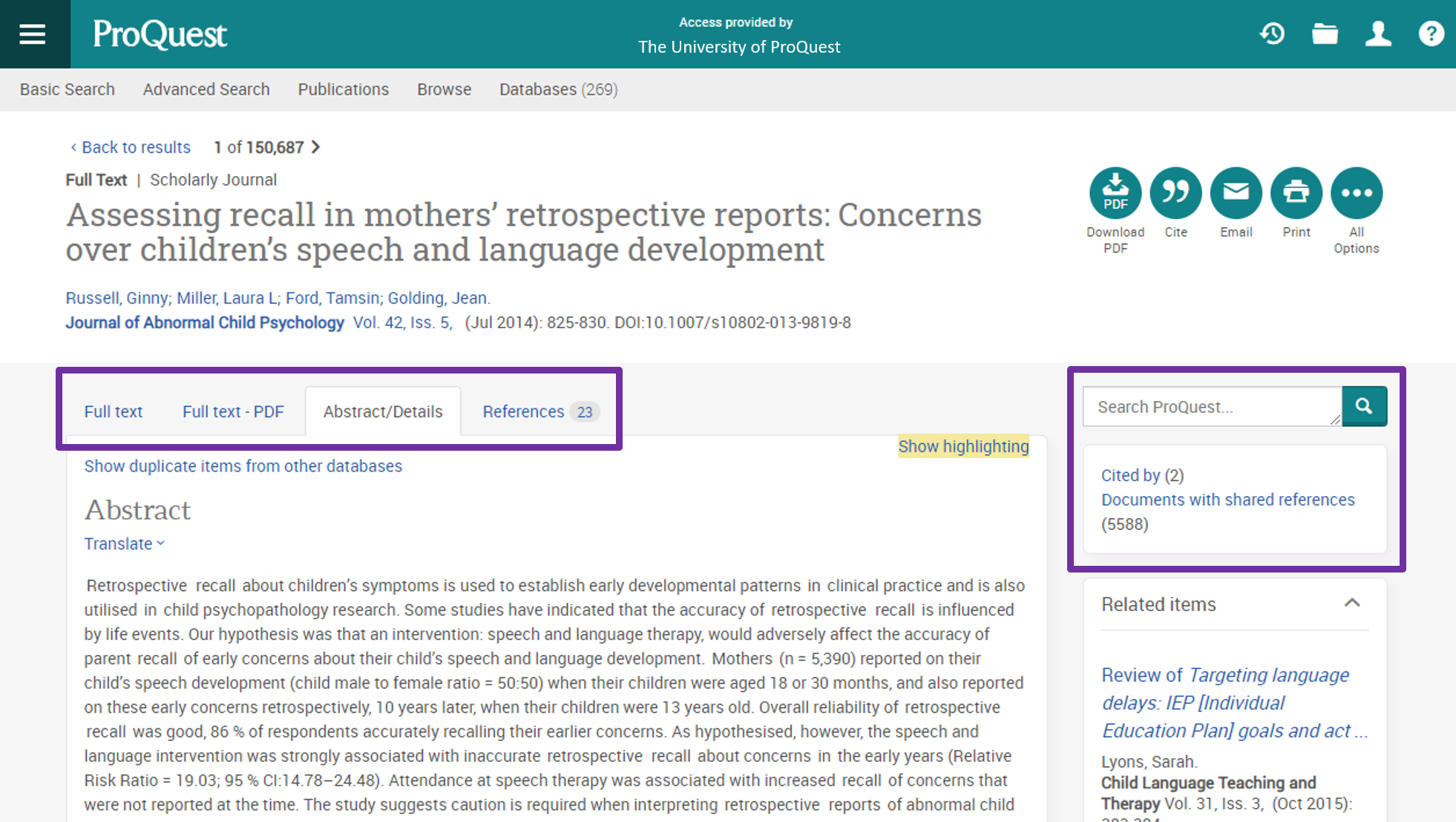
As always, we welcome your feedback.
Please contact us if you have questions or feedback.
March 2021: Round up of recent ProQuest Platform enhancements
We are always looking for ways to improve access and make the ProQuest Platform easier to use for you and your users. Over the past few months, we’ve shared several big improvements such as entry from the open web, improved access to subscription and open access content, and announced the ProQuest Platform's accessibility statement received ASPIRE certification. During this time, we also released several other features and capabilities to streamline workflows for your users in an increasingly interconnected world of digital learning and research. Here are the highlights:
Authentication
Integration with Learning Management Systems
There’s now an easier way for higher-education faculty and K-12 teachers to use library content in their course curriculum. ProQuest is proud to announce new integration capabilities between the ProQuest platform and learning management systems (LMS), including Canvas and Moodle (with more to come). Integrate ProQuest with your Learning Management System
New Output Options
- To make it easier for users to save ProQuest documents to the citation manager of choice, they can now export citations to a citation manager or file directly from the ‘Cite’ view.
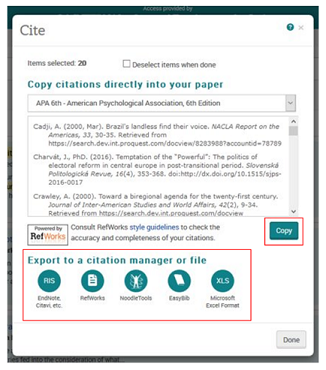
- NoodleTools added as an Output option: Users can now export references directly to their NoodleTools account from the ‘Cite’ and ‘Save as’ views on the ProQuest Platform.
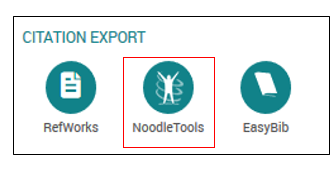
As always, we welcome your feedback. Please contact us if you have questions, feedback or other concerns.
October 2020: ProQuest Platform now ASPIRE certified
We are proud to announce that the ProQuest Platform has received the maximum score of 100 percent in the ASPIRE verified Accessibility Audit for the quality of the ProQuest Platform accessibility statement. This achievement recognizes an organization’s commitment to ensuring its accessibility statements are a true representation of the accessibility of the platforms they describe in order to provide full transparency to both customers and end-users.
Both the ProQuest Platform and Ebook Central have achieved a gold ASPIRE review. You can view the ASPIRE platform list here: https://www.textboxdigital.com/aspirelist-platforms
The ProQuest Platform Accessibility statement is available here: https://about.proquest.com/go/accessibility-platform
July 2020: New enhancements improve discovery and adds more open access content
On July 30, ProQuest released several new enhancements to the ProQuest Platform. These enhancements are part of our larger, ongoing initiative to add value to our solutions, expand pathways to access and help libraries increase usage of their resources. No action is required by you or your users to activate these improvements.
• Expand Results checkbox
• Publicly Available Content Database now available to all ProQuest Platform customers
Expand Results checkbox
To better support users who require added context to complete their research tasks, a checkbox labeled “Show results outside my library’s subscription” will be added to the search results page. When the checkbox is selected by the user, their search results will expand to include relevant ProQuest content outside the library’s subscription alongside entitled content.
Let’s say a student is using ProQuest to search for information on running biomechanics, and her search returns a limited number of results. She can use the new functionality to include relevant ProQuest content outside of her library’s subscription and explore her topic through a more comprehensive result set.
Expanded results unchecked
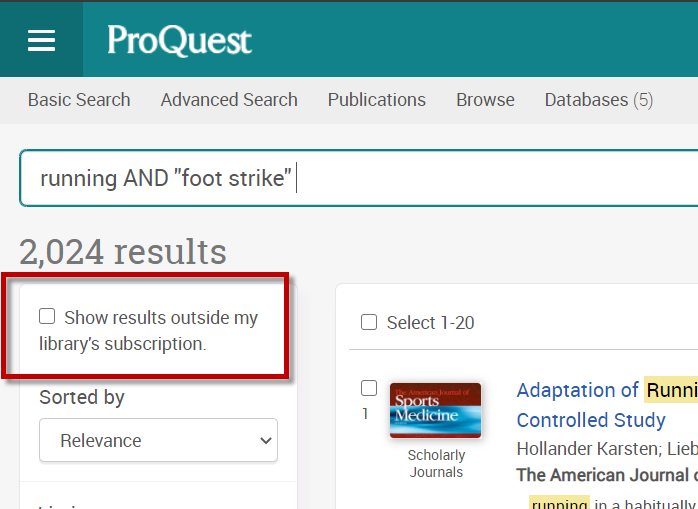
To see these additional items, users simply need to check the box to “Show results outside my library’s subscription”. Note unchecking the box will return the results to its original state.
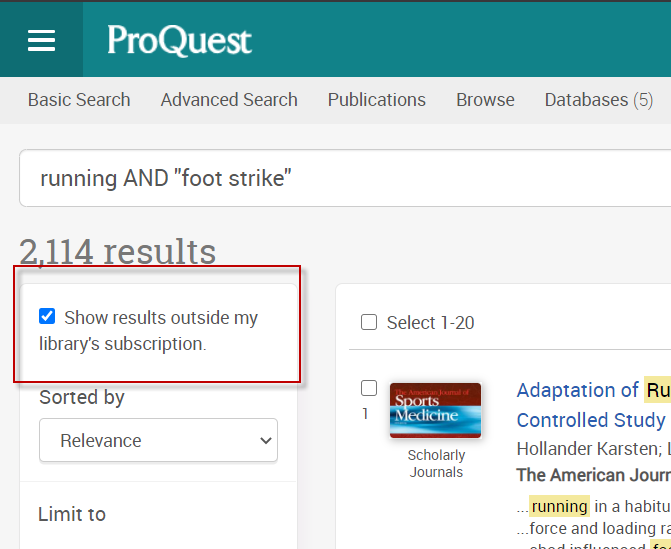
The label to the right of the results item indicates the level of availability as based on format and a user's entitlement e.g. 'Full Text', 'Citation/Abstract' or 'Preview Available'.
By default, the expanded results checkbox is visible for all customers. Keep in mind, searches are limited to your available databases. Your users must choose to expand their results to include these additional items and this can only be done from the search results page with two or more databases selected. However, if there are concerns about making non-subscribed content available to users, your library administrator can disable this functionality in the ProQuest Administrator Module. Instructions on how to opt out of preview and open access items is provided here.
Publicly Available Content Database now included with all ProQuest Platform subscriptions
As part of our goal to improve access to subscription and open access content, libraries with at least one ProQuest Platform Database will have the Publicly Available Content Database added to their subscriptions at no charge.
Now your users can search thousands of reliable open-access scholarly full text sources without leaving the ProQuest Platform.
The Publicly Available Content Database includes vetted coverage of reliable scholarly sources – and excludes potentially problematic publications that are inconsistent with ProQuest's editorial guidelines. The Publicly Available Content Database is available at this link on the ProQuest Platform.
Access the ProQuest Platform from www.proquest.com
Now your users can start their research by going directly to www.proquest.com to enter the ProQuest Platform. If they are on campus and IP authenticated they'll search the ProQuest content provided by your library. Unauthenticated users will be able to search and preview content and be required to authenticate to access susbscriber only content. No work is required on your end to enable this and none of your links will be impacted. Tell your students and faculty to simply "Go to ProQuest.com" to access your library's ProQuest content. In addition, the new structure includes links to about.proquest.com where you will find product information and the latest ProQuest news.
Please contact us if you have questions, feedback or other concerns.
June 2020: Direct entry from the open web | Search, find and preview over 900M documents on the ProQuest Platform without authenticating
Earlier this week, we released a series of enhancements which enabled direct entry into the ProQuest Platform from the open web. This functionality allows users to search, find and preview more than 900 million documents without authentication and retrieve Open Access full-text content curated by ProQuest.
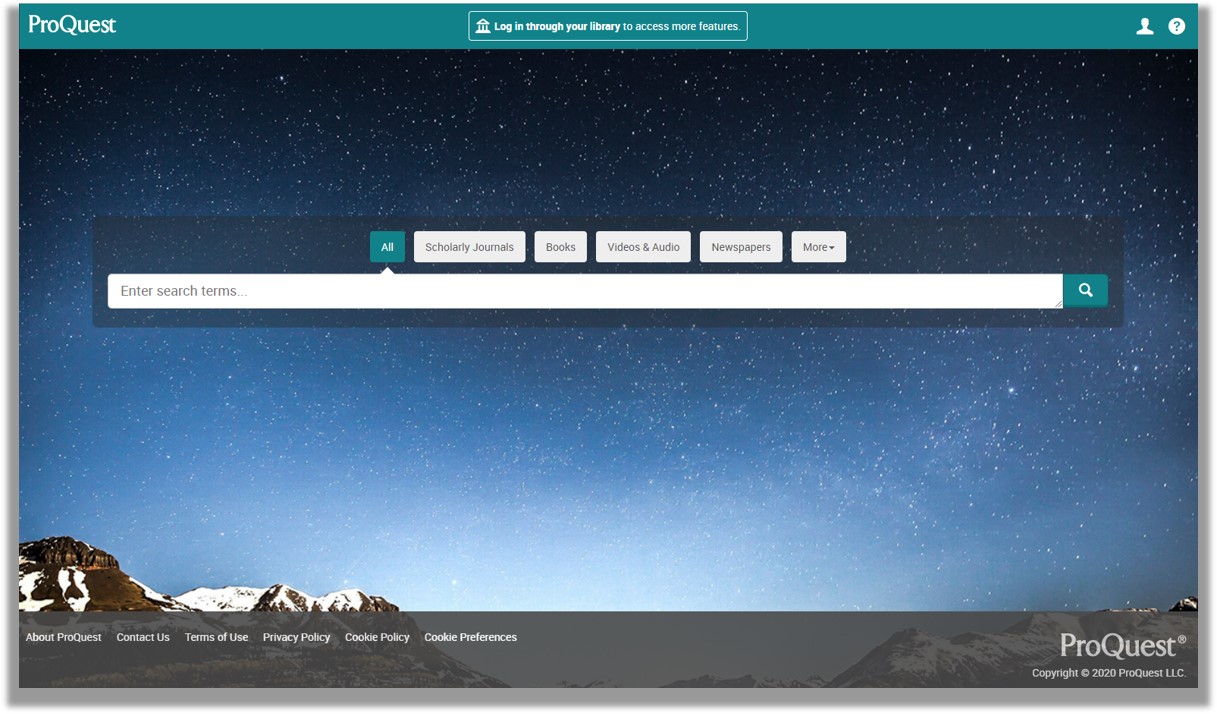
This update helps libraries “meet users where they are,” giving students, faculty and researchers fast and frictionless access to their ProQuest content for remote research and learning.
It’s the first in a series of enhancements that will streamline research, extend pathways to access and increase usage of the materials libraries have invested in. In the coming months, ProQuest content will be accessible directly from major search engine results.
There is no action required by you at this time. These enhancements will be automatically released for the benefit of your library and its users.
This release also includes several enhancements to make it easier for your users to authenticate into ProQuest and raises the prominence of your library throughout the interface. Here are the details:
- Improved Authentication Process: The new preview functionality includes login prompts at multiple points to encourage the user to authenticate so they can access their institution’s owned/subscribed content and their usage can attributed to their library. Thus, we’ve improved the authentication process to make easier for users to find their institution either by searching for it by name or using their institutional email address. Once authenticated, users temporarily logged into the ProQuest Platform for up to 90 days after their authentication. This will not only reduce the impact on institutions remote access facilities but also ensure users’ access to content at the point when they need it.
- Boosting Visibility of the Library within the ProQuest Platform: Once authenticated, users will see the name of their authenticated institution in the header of page. This will raise the prominence of the subscribing institution and help reinforce the service provided by the library.
Frequently asked questionsPlease review our
Frequently Asked Questions on entry from the open web article for additional information.
These are the first in a series of enhancements that will streamline research, extend pathways to access and increase usage of the materials libraries have invested in.
Please contact us if you have questions, feedback or other concerns.
January 2019
Streamlined Access to More ProQuest Content
Our next release will make content from these ProQuest resources discoverable and usable on the ProQuest Platform, and introduce a redesigned search results page:
Now, researchers can search six centuries of content, spanning virtually every discipline and format – including primary sources, journals, ebooks, dissertations, news and video – without re-authenticating on another platform. This seamless user experience improves search and discovery for teaching, learning and research.
Find Ebook Central Titles on the ProQuest Platform
Libraries with subscriptions on Ebook Central such as Academic Complete and ProQuest databases such as ProQuest Central will be able to find and use ebooks directly on the ProQuest platform. The new experience mirrors what users currently see on Ebook Central. Note we'll provide an update soon on when this functionality will be available to Ebook Central customers with titles available only via PAL and/or DDA.
Book detail page: The book detail pages on both platforms look nearly identical (see the ProQuest platform version below). Expand the table of contents, view a title’s availability, download content or navigate to the online reader.
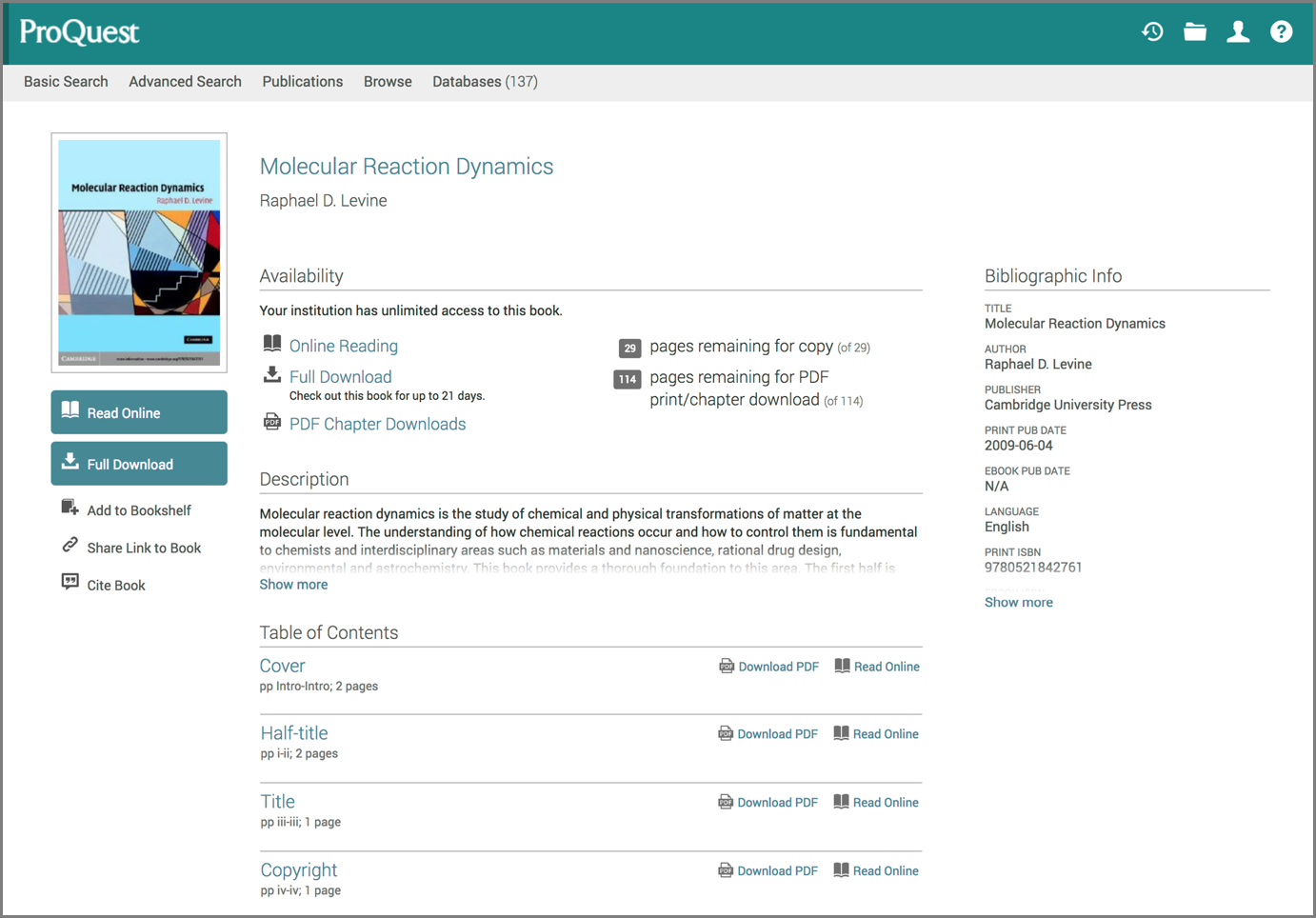
Ebook reader: The ebook reader on the ProQuest platform (example below) will also mirror its counterpart on Ebook Central. Users will be able to highlight, annotate, cite, and navigate through the table of contents and to the chapter level just as they do today on Ebook Central.
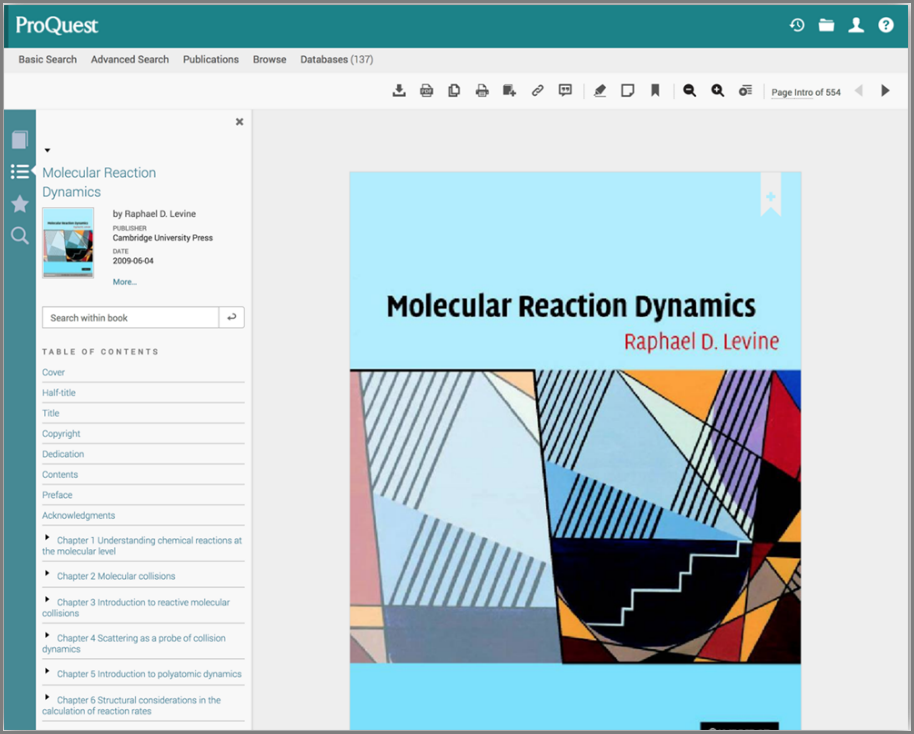
When a user attempts to download, save to PDF, copy, print, save to bookshelf, highlight, annotate or bookmark, they’ll be prompted to log into their bookshelf account. In this first release, ebook customers will need to log into two separate user accounts to save documents: My Bookshelf for Ebook Central and My Research for the ProQuest platform. Integration of this functionality will be a priority for 2019.
Collection management: Ebook Central collection management will continue on LibCentral, the administrative portal for LibCentral.
Back to the topWatch Academic Video Online Videos on the ProQuest Platform Academic Video Online customers will now be able to find and watch streaming video on both the native Alexander Street interface and the ProQuest platform. The video experience, including synchronized transcripts, will mirror the Alexander Street platform viewing experience. Clip- and playlist-making functionality will come to the ProQuest platform in a future release.
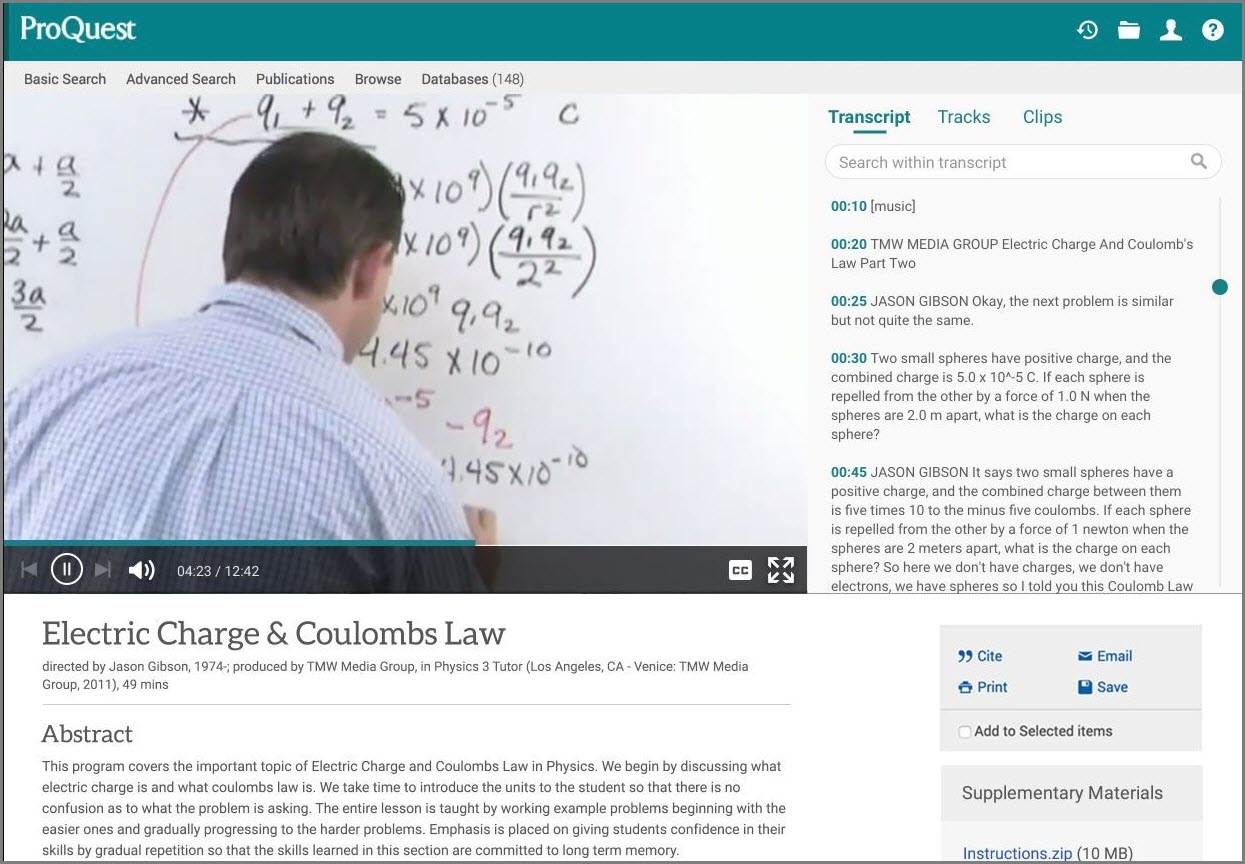
Literature Online Moves to the ProQuest PlatformLiterature Online is moving from its legacy Chadwyck-Healey interface to the ProQuest platform. Dual access will start with this release and will continue through mid-2019, giving users ample time to get comfortable with the benefits of the new experience. Get the details on the
Literature Online customer resource page.Back to the topRedesigned Search Results PageIn addition to adding more content, we’re redefining how it’s delivered. After consulting with librarians, students and faculty, we’ve redesigned the search results page to help prevent information overload. You’ll see two new sidebars on the right side of your search results displaying the most relevant ebooks and videos. Enhancements like these make it easier for your users to interact with the varied content types users need to complete their work.
Bookmark this Page for More Updates
Soon, we’ll post links to the updated ProQuest platform LibGuide, along with other tools to help you and your users get up to speed on these changes. Questions or concerns in the meantime?
Submit your feedback.
Back to the top
The July 2018 ProQuest platform release introduced a redesigned basic search page. These improvements put more emphasis on source types to help researchers retrieve more relevant results from across the platform. Here’s a summary of the enhancements included with this release:
Basic Search page
- Source type limiter: A horizontal source type limiter was added just above the basic search box to help users limit their results to the content types most meaningful to them. The limiter displays the top three to four source types available within the users selected databases. Further source types are available under a ‘More’ menu. The order of source types is determined by usage analytics and qualitative feedback from end users.
- Search tips: To better support researchers at the point of need, thoughtfully placed help panels provide search guidance at the point of the most need. To make room for the help panels, the subject vertical links were removed (but these can still be accessed via the ‘Databases’ page).
- “You are searching…” statement: To better orient researchers who start their search from the basic search page, a statement was added that tells them how many databases they are searching and the top source types contained within those databases.
Search results page
- Filters: Through a close examination of user behavior, we’ve simplified the filters menus so that the most useful are displayed by default and made the less used filters accessible from the ‘More’ menu.
Additional improvements
- Records counts are removed from the Source Type filter
- The date picker has been simplified
- Clearer indicator of Full text/Abstract/Details
- Revised display for inline images
- Long document titles will be truncated/limited to 3 lines
- The check boxes for full text/peer reviewed were removed from underneath the search field on results page.
Back to the top
May 2018
The latest ProQuest platform release includes changes to SUSHI generated COUNTER 4 journal reports:
- Effective May 21 COUNTER 4 Journal reports generated using SUSHI clients will no longer report journals with zero usage. Only positive usage metrics will be reported.
- This will ensure the reports are able to be generated and reported in a timely manner for SUSHI clients.
- Journal reports generated in the ProQuest Administrator Module (PAM) for the tab-separated (Excel-compatible) or HTML formats are not impacted by this change; they will continue to support the reporting of zero-usage. Only the XML formats harvested through SUSHI will no longer support the generation of zero usage
- Lastly, no changes are required by the library administrator and ProQuest reports remain COUNTER 4 compliant.
Please contact ProQuest Technical Support if you have questions on these changes.
Back to the top
January 2018
The latest ProQuest platform release includes changes to the document view to make it easier for your users to find related content:
-
Previously, the Related Items panel on the right-hand side of the document view was closed by default. In order for users to see related content, they needed to click to open the panel. With this release, the Related Items panel will be open by default.
- Our usage analysis showed that a high percentage of users who used the Related Items panel follow the links to view at least one more document on the ProQuest platform. The recommendations reflect both documents used in conjunction with the presently viewed document and documents with similar indexing.
- These recommendations are similar to when a website like Amazon suggests other products that have been purchased along with the product being viewed in the same transaction. These changes are now live for all institutions using databases on the ProQuest platform.
Back to the top
Get Started
Have a question? Review the latest FAQ’s on the ProQuest Platform.
Watch our YouTube videos. Check them out here.
Training
- Live and recorded trainings are available. Check out the schedule here.
- Libguide: a complete online guide for your users.
Global Support
ProQuest offers best-in-class customer service and technical support, so you can hit the ground running.
If the above information does not answer your questions feel free to contact us and we will be happy to assist.




